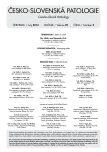-
Články
Top novinky
Reklama- Vzdělávání
- Časopisy
Top články
Nové číslo
- Témata
Top novinky
Reklama- Kongresy
- Videa
- Podcasty
Nové podcasty
Reklama- Kariéra
Doporučené pozice
Reklama- Praxe
Top novinky
ReklamaSigns of self-inflicted wounds; how accurate they are
Keywords:
self-inflicted wounds – forensic – signs
Authors: Nasim Zamani
Authors place of work: Department of Forensic Medicine and Clinical Toxicology, Tehran University of Medical Sciences, Tehran, Iran
Published in the journal: Soud Lék., 58, 2013, No. 3, p. 47
Category: Dopis redakci
Summary
Keywords:
self-inflicted wounds – forensic – signsDear Editor:
Differentiating the intentionally self-inflected wounds from the real ones is an important point in the clinical field of forensic medicine. As described in one of the most famous forensic textbooks - Knight’s Forensic Pathology - the most important clinical signs of these intentionally self-inflicted wounds include left-side injuries in the right-handed patients (especially in the areas available to the patient), regular, superficial, and parallel wounds avoiding vital and sensitive areas, and irrelevant garment cuts not matching the injuries in position and direction (1). Seeing a horizontal tear on the garment and a vertical wound beneath, a forensic specialist generally thinks of an intentional self-inflicted wound. I, however, present a case of real injury with all these features.
The patient was actually a close relative of mine who hurt himself while handling a 1x1.5 meter, 8-mm thick glass leaning to the wall. Wile trying to remove the glass, it slid, fell on the patient’s left arm and then dropped, tore the left sleeve of his shirt horizontally and made two parallel vertical superficial wounds on his arm. I would like to tell that even such famous signs that are considered as signs of intentional self-inflicted injuries, taught by famous forensic textbooks worldwide, and considered in the management of those referring to the forensic organizations for examination, are not a hundred percent correct and may all be present in a case of real injury. A specialist in Forensic Medicine should, therefore, always keep such possibilities in his/her mind while confronting a patient with possible self-inflicted wounds.
Reviewer’s comment:
The necessity to consider all circumstances in the case of suspicion on self-inflicted injury is not discuss.
Correspondence address:
Nasim Zamani, MD
Department of Clinical Toxicology
Logman Hakin Hospital, Shahid
Beheshti University of Medical Sciences, Teheran, Iran
tel.: 00989122059290
e-mail: nasim.zamani@gmail.com
Zdroje
1. Saukko P, Knight B. Self-inflicted injury. In: Saukko P, Knight B, eds. Knight’s Forensic Pathology. London; Edward Arnold; 2004 : 235–44.
Štítky
Patologie Soudní lékařství Toxikologie
Článek Expert Forensic ScienceČlánek Záchrana v zimě
Článek vyšel v časopiseSoudní lékařství

2013 Číslo 3-
Všechny články tohoto čísla
- Pohlavní rozdíly v ovlivnění jedince alkoholem
- Úmrtí v důsledku arytmogenní dysplasie pravé komory srdeční: Kazuistika
- Expert Forensic Science
- Úrazové změny nitrohrudních orgánů vzniklé při externí mechanické kardiopulmonální resuscitaci. Kazuistiky
- Záchrana v zimě
- Náhlé úmrtí při vysokém odstupu věnčité tepny
- Signs of self-inflicted wounds; how accurate they are
- Nejlepší monografie a nejlepší článek (Kritéria pro nominaci na cenu ČSSLST)
- Soudní lékařství
- Archiv čísel
- Aktuální číslo
- Informace o časopisu
Nejčtenější v tomto čísle- Úrazové změny nitrohrudních orgánů vzniklé při externí mechanické kardiopulmonální resuscitaci. Kazuistiky
- Pohlavní rozdíly v ovlivnění jedince alkoholem
- Náhlé úmrtí při vysokém odstupu věnčité tepny
- Úmrtí v důsledku arytmogenní dysplasie pravé komory srdeční: Kazuistika
Kurzy
Zvyšte si kvalifikaci online z pohodlí domova
Autoři: prof. MUDr. Vladimír Palička, CSc., Dr.h.c., doc. MUDr. Václav Vyskočil, Ph.D., MUDr. Petr Kasalický, CSc., MUDr. Jan Rosa, Ing. Pavel Havlík, Ing. Jan Adam, Hana Hejnová, DiS., Jana Křenková
Autoři: MUDr. Irena Krčmová, CSc.
Autoři: MDDr. Eleonóra Ivančová, PhD., MHA
Autoři: prof. MUDr. Eva Kubala Havrdová, DrSc.
Všechny kurzyPřihlášení#ADS_BOTTOM_SCRIPTS#Zapomenuté hesloZadejte e-mailovou adresu, se kterou jste vytvářel(a) účet, budou Vám na ni zaslány informace k nastavení nového hesla.
- Vzdělávání



